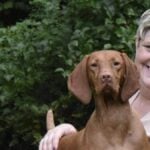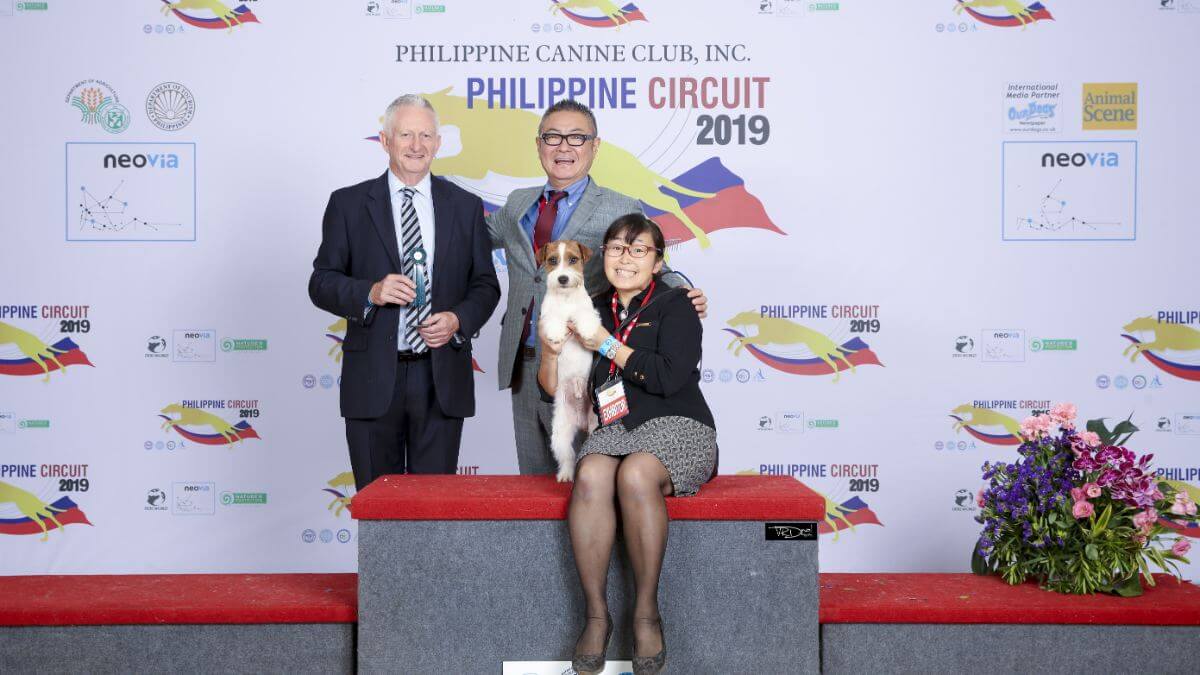
Home » Monamour Jack Russell Terriers (Japan) – Mr. Hiroshi Tsuyuki & Ms. Kao Miichi

Mr. Hiroshi Tsuyuki & Ms. Kao Miichi: The breed has been originated in the U.K. The Jack Russell Terrier takes his name from the famous hunting gentleman named the Reverend John Russell who hunted the moors of Devon (UK) over 100 years ago.
Although the Jack Russell Terrier is a native breed, it was Australia where the breed was developed and first recognized. These dogs came from terriers that were exported from the U.K. from several well-known kennels. The Australian Russell Terrier Club was formed in 1972; they started recording and researching pedigrees. The Breed Standard was formalized in 1983. After a lot of hard work and clever breeding, the breed became recognized by the A.N.K.C in 1990; however, by 1994, they closed their stud book and no longer accepted dogs registered with the Jack Russell Terrier Club of Australia. The Russell first appeared in the show ring in Australia in 1991 and the rest of the world quickly recognized this popular breed.
The original proposal for AKC acceptance was written by JoAnn Stoll and submitted to AKC in late 2004. The breed was accepted on the club’s first submission. The Russell officially went into AKC FSS in October 2005. In a letter from Mari-Beth O’Neill, dated 10/9/2007, the American Russell Terrier Club was named as parent club for the new AKC Russell Terrier. On January 1, 2010, the Russell Terrier was allowed to compete in the Miscellaneous Class. Then, effective June 27, 2012, we were officially the 175th recognized breed and allowed to enter the Terrier Group. In 2016, The Kennel Club recognized the Russell Terrier as a breed. It is apt that the U.K. Interim Breed Standard is a carefully blended version of the U.K., FCI, and Australian Standards. We started showing Russell Terriers in the U.K since Crufts 2017. The Royal Kennel Club decided to issue the very first C.C. at Crufts 2024.
Mr. Hiroshi Tsuyuki & Ms. Kao Miichi: In the structure, they should all be the same. Many of the smooth-coat Russell Terriers have snipey faces and narrow muzzles, which are incorrect. The rough-coat Russell Terriers can have a problem with an incorrect soft coat. All coats should have a weatherproof texture with a good amount of undercoat.
Mr. Hiroshi Tsuyuki & Ms. Kao Miichi: A Lot. There are still a lot of different bloodlines, especially the working type of Russell Terriers.
Mr. Hiroshi Tsuyuki & Ms. Kao Miichi: They can have 51 percent white marking on the body. For myself, too heavy-marked dogs can produce heavy-marked puppies. They should not be 100 percent white in color, as it can cause problems.
Mr. Hiroshi Tsuyuki & Ms. Kao Miichi: “Medium.” They should not look like small Parson Russell Terriers or Smooth Fox Terriers, but also, they should not look like they have Sealyham Terrier proportion. The Russell Terrier should look “medium,” not too long in the body, not too short in the body or back. They should look rectangular at first sight. The silhouette of “rectangular” is important for me, not the off-square silhouette. Many people judge Russell Terriers by pointing to their small faults such as the size of their ears, tail, or eye color.
Mr. Hiroshi Tsuyuki & Ms. Kao Miichi: If they have a pleasant weatherproof coat, I do not mind any coat type, but if I must choose, I prefer a broken coat. I do not care about which type of coat they have if the dog has the correct proportion of body and movement. But with over 20 years of experience, a broken coat Russell Terrier has the best coat and skin; a good weatherproof coat texture.
Mr. Hiroshi Tsuyuki & Ms. Kao Miichi: Considerations that breeders must take into account when selecting desired traits: Breeding Russell Terriers is not easy because they produce everything; too tall, too small, too big, too long, too short, meaning, you can get everything in one litter. First, we should breed the type and size consistently. Always pick a puppy that has the correct proportion and balance, and keep this puppy for approximately 18 months to see how the details look. You can change the small details in the next breeding. It is not easy to breed them consistently.
Mr. Hiroshi Tsuyuki & Ms. Kao Miichi: Russell Terriers have a very positive, happy temperament and are not aggressive at all. They love working with people; they love to make people happy. However, this type of temperament causes a problem with the movement of the Russell Terrier. Russell Terriers can move with their happy temperament even though the structure is incorrect. People call this busy movement as cute! But this is NOT correct at all. The movement should come from the correct structure of the dog. The judge must look at the correct movement from the front and rear angulation and not the busy, small movement of just a happy dog.
Mr. Hiroshi Tsuyuki & Ms. Kao Miichi: They can have a good relationship with other dogs, people, and kids. So many people have been showing other breeds. Russell Terriers have the temperament of a large breed, but they are small and easy to live with. Russell Terriers are the best breed for Owner-Handlers and/or Junior Handlers, I believe.
Mr. Hiroshi Tsuyuki & Ms. Kao Miichi: The most important thing is NOT to choose them at a young age like 8 weeks or 12 weeks. Some people say they can tell if the puppy is a show prospect or not. I cannot choose a Russell Terrier puppy at that age. I keep them for at least 6 to 12 months, to see if they mature to be the correct proportion.
Mr. Hiroshi Tsuyuki & Ms. Kao Miichi: I prefer Malung, the Russell Terrier kennel in Australia, dating back to 1980.
Mr. Hiroshi Tsuyuki & Ms. Kao Miichi: You cannot breed a consistent type (proportions/silhouette) and quality. As I answered in the previous questions, all types can be produced in one litter. We should be very patient to keep the correctly proportioned dogs to make our kennel foundation, then try our best to improve the details.
Mr. Hiroshi Tsuyuki & Ms. Kao Miichi: They are working terriers and should not be overgroomed. We always try to make the dog’s coat functional, meaning weatherproof and waterproof.
Mr. Hiroshi Tsuyuki & Ms. Kao Miichi: Some Russell Terriers have congenital intestinal disorders called IBD. Some still have patella problems. Most Russell Terriers are much healthier than other, older breeds.
Mr. Hiroshi Tsuyuki & Ms. Kao Miichi: Three to five years old.
Mr. Hiroshi Tsuyuki & Ms. Kao Miichi: Russell Terriers are totally different from other terrier breeds. They are way too smart. They like people and like working with people. On the other hand, they are very loyal and do good work only for those who love and care for them. Therefore, Russell Terriers are a breed of dog that needs to live in people’s homes, be raised with care, and be taken to dog shows, rather than being kept in large numbers in kennels to be a “show machine.”
Mr. Hiroshi Tsuyuki & Ms. Kao Miichi: NO gluten, NO kibble-only food. I feed them a BARF Diet (70 percent meat, 10 percent Tripe and bones, and 20 percent vegetables and fruits).
Mr. Hiroshi Tsuyuki & Ms. Kao Miichi: I sent my breeding dog MAX to France in 2012. The owner in France owned a dog from Norway named NORWAY. She bred the bitch to MAX and then ZEN (Crufts winner) was born. That is the beginning of this long journey. We have won a lot with ZEN: The Russell Terrier National Specialty in the US; World Winner title; Japan’s No. 1 dog; and so on… but Crufts Reserve Best in Show was a lifetime dream.
Mr. Hiroshi Tsuyuki & Ms. Kao Miichi: He is a one-in-a-million dog. His movement tells the structure he has. His structure is almost perfect, and his movement is like a dream. His temperament is stunning. I believe he has everything a Russell Terrier should be.
Mr. Hiroshi Tsuyuki & Ms. Kao Miichi: Nothing. He lives in my bedroom, we go for a walk every day, and I feed him the best nutrition. This is ZEN. If the dog has the correct temperament and structure, we do not need any particular training. He is gifted.
Mr. Hiroshi Tsuyuki & Ms. Kao Miichi: 2024 Crufts was incredibly memorable. It was a historic moment. ZEN was Best of Breed; the very first C.C. ticket for the breed. He went on to be Reserve Best in Show.
Mr. Hiroshi Tsuyuki & Ms. Kao Miichi: We do nothing special. We live in the countryside of Japan. We have clean air and a lot of trees in the forest. Dogs can play all day under the sunshine and have lots of socialization. Nutrition is very important, and I do not feed them only kibble; always a BARF diet.
Mr. Hiroshi Tsuyuki & Ms. Kao Miichi: Do not get a dog strictly for dog shows or competitions. Your dog should be your best friend and companion to live with. Treat them like a treasure, love them, train them, and feed them the best.
Mr. Hiroshi Tsuyuki & Ms. Kao Miichi: I provide them with a lot of rest in a comfortable crate and give them the best nutrition while traveling. The most important thing is for show dogs to have the correct temperament so that the dogs will never feel stressed or pressured. They should believe the dog show is a play-game with their mom and dad.
Mr. Hiroshi Tsuyuki & Ms. Kao Miichi: It does not matter. With or without success, my dogs are my children. My dogs are my life and not a dog-like beauty contest. We show our dogs in their normal condition, relaxing and happy. If they did well, I am happy, but if they did not win, they are still my treasure.
Mr. Hiroshi Tsuyuki & Ms. Kao Miichi: Dog shows are a place to choose the correct specimen for the breed’s future. We do not think of dog shows as a dog-like beauty contest. We show our dogs in their normal condition, relaxed and happy.
Mr. Hiroshi Tsuyuki & Ms. Kao Miichi: We never trained our dog to be a “show dog.” He was a natural. He loves dog shows. I think he was born with a very special temperament and character.
Mr. Hiroshi Tsuyuki & Ms. Kao Miichi: I am slowly retiring from breeding dogs. I’ll do more educational breed seminars, nutritional seminars, and judging.